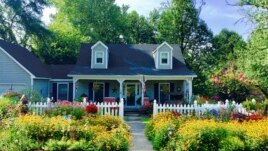17 April 2023
Wildflower meadows have been growing in popularity among gardeners – and for good reason.
A meadow is a usually flat area of land that is covered with tall grass. Meadows are easy to take care of, do well with little water, and provide food for birds, animals, and insects. And they are nice to look at.
Wildflowers are native plants. So, if you want to create your own wildflower meadow, your plant choices will depend on where you live.

This image provided by American Meadows Inc. shows a lush wildflower meadow growing in place of a residential lawn. (American Meadows Inc. via AP)
If you are in the United States or Canada, start your search on the Lady Bird Johnson Wildflower Center's website www.wildflower.org/plants/. Choose your area and narrow the search by choosing your water and sun requirements, among other choices. Then, take a look at the list for plants that you like.
The usual meadow is about 60 percent native grasses and 40 percent flowering perennials. But there is no harm in changing these amounts.
You can also buy ready-made wildflower seed mixes made for your area. If you choose this, just be sure that the kinds of plants included work for the soil, sunlight, and wetness conditions your garden provides.
But do not think you can just spread the seeds and walk away. You must always prepare your soil for any garden, wild or not. If you do not, you will likely not enjoy your results.
First, remove any unwanted plants and grasses that are already present. Digging them up would require the most amount of work, and risks moving the seeds of unwanted plants to the surface. That could make problems worse.
A more effective way to remove grasses and unwanted plants is by using high temperatures or removing oxygen from the area. These methods do require time.
Place cardboard over your garden and then cover it with 10 to 15 centimeters of mulch. The grass and other unwanted plants under it will die from not having enough oxygen by autumn.
Another method is to cover the area with weighed-down plastic. This method can be quicker because as the plastic heats up, it "cooks" the plants under it.
This autumn (or next spring), turn the soil in the new bed and include a small amount of compost. If you have heavy clay soil, mix in sand to improve water flow. Do not add fertilizer or use too much compost, because wildflowers do better with low soil fertility.
Yearly wildflower plants should be planted only in spring, to permit time for them to grow, produce and drop seeds, which will begin to grow the following year. Perennial plants, however, can be planted in fall.
Most wildflower seeds are very small, so combining one part of your seed mix with 10 parts of dry sand can make spreading them easier. Spreading the seeds by hand may work for small beds, but it is better to use a seed spreader for larger areas.
To make sure the seeds get good contact with the soil, walk over them or pass over the area with a garden roller. But be sure to not bury the seeds.
If you are spreading the seeds in spring, keep the area lightly watered if there is no rainfall, as the season's warming temperatures will threaten to dry them out.
Expect some yearly plants to flower the first year, but you may have to wait a year or two for perennials to flower. In the meantime, keep the bed free of tall unwanted plants, which could take away sunlight from your growing wildflowers.
At the end of the growing season, leave your meadow standing to provide food and shelter for overwintering insects and wildlife. Cut it down in spring just before new growth begins.
I'm Gregory Stachel.
Jessica Damiano reported this story for The Associated Press. Gregory Stachel adapted it for VOA Learning English.
_________________________________________________________________
Words in This Story
garden – n. an area of ground where plants (such as flowers or vegetables) are grown
perennial – n. a plant that lives for several years or for many years
cardboard – n. a stiff and thick kind of paper that is used especially for making boxes
mulch – n. a material (such as straw, leaves, or small pieces of wood) that is spread over the ground in a garden to protect the plants or help them grow and to stop weeds from growing
compost – n. a decayed mixture of plants (such as leaves and grass) that is used to improve the soil in a garden
clay – n. a heavy, sticky material from the earth that is made into different shapes and that becomes hard when it is baked or dried